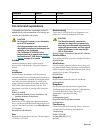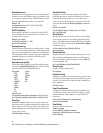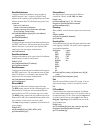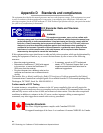
xv
ATTO Technology Inc. FastStream VT 5300 Installation and Operation Manual
RAIDCommandTimeout
Specifies in milliseconds the range of time the drives have
to respond. You must use
RGCommit
before using this
command.
CAUTIONCAUTION
If you set this value too low, failures may
occur during normal operation.
Default: 30000
set RAIDCommandTimeout [100 - 3600000]
get RAIDCommandTimeout
RAIDRebuildPriority
Sets or displays the RAID rebuild priority. A RAID
rebuild priority set to
high
gives higher priority to RAID
rebuilds and lower priority to the processing of
simultaneous I/O transactions. A RAID rebuild priority
set to
low
gives lower priority to the rebuild and a higher
priority to I/O transactions. Set
same,
the RAID rebuild
and processing of I/O transactions is the same.
Default: same
set RAIDRebuildPriority [high | low | same]
get RAIDRebuildPriority
Reserve
Reports the state of CLI reservation for the current CLI
session. If the command reports that Reservations are
enabled, then another CLI session has control of
parameter modification on the unit.
Reserve
ResetFCPortErrors
ResetFCPortErrors resets all Fibre Channel error counts
for the specified port to zero. See FCPortErrors.
ResetFCPortErrors [fp]
RestoreConfiguration
Issued with the
default
option, forces the unit NVRAM
settings to their original defaults. The
saved
option
undoes any changes made to this session since the last
save.
RestoreConfiguration < Default | Saved >
RGAddStorage
Adds additional storage to an existing RAID Group.
Mirror|Stripe|Span
specifies the method used to
expand the storage. Optional parameter BlockDeviceID
specifies available block device(s) to be added to the
RAID Group. Optional parameter
commit
specifies that
the
RGCommit
command is run automatically.
Note
Mirrors cannot be added to a RAID 5 group.
RGAddStorage [GroupName] [Mirror | Stripe | Span]
<BlockDeviceID> <commit>
RGCancelAddStorage
Cancels the
RGAddStorage
command.
RGCancelAddStorage [GroupName]
RGCommit
Stamps a NEW RAID Group’s configuration to its
member drives. After this command, a RAID Group can
be considered operational and transitions from the NEW
state to the
Online, Degraded
, or
Offline
state
depending on the health of the selected member drives.
RGCommit
also stamps an EXISTING RAID Group’s
configuration to its member drives, when the EXISTING
RAID Group is in the process of having storage added.
RGCommit [GroupName | all]
RGCreate
Creates a NEW empty RAID Group. GroupName is an
ASCII name for the RAID Group (15 chars max, no
spaces). The optional value after the RAID Group type
parameter represents the desired interleave for the RAID
Group. If this value is not provided then the system-
default interleave size is used.
RGCreate [GroupName] [RAID [0|1|10|5] |JBOD]
<16|32|64|128|256>
RGDelete
Deletes the specified RAID Group. If
All
is used, the
command deletes all existing RAID groups that do not
have mapped Virtual drives. Any commands outstanding
to the RAID Group when this command is issued are
completed before deleting the RAID Group. A successful
delete clears the configuration area of the member drives.
This command fails if the specified RAID Group does not
exist. You are asked to confirm the delete if you have
enabled verbose mode.
RGDelete [GroupName | All]


















